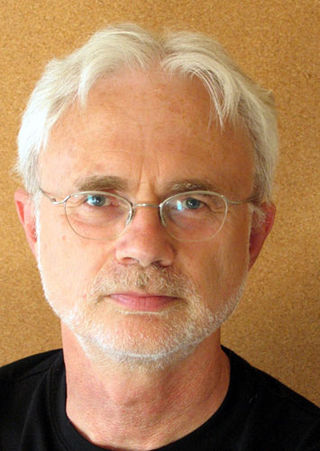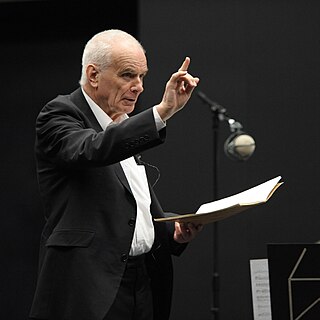Related Research Articles

John Coolidge Adams is an American composer and conductor. Among the most regularly performed composers of contemporary classical music, he is particularly noted for his operas, many of which center around historical events. Apart from opera, his oeuvre includes orchestral, concertante, vocal, choral, chamber, electroacoustic, and piano music.

Sir Peter Maxwell Davies was an English composer and conductor, who in 2004 was made Master of the Queen's Music.

Doctor Atomic is an opera by the contemporary American composer John Adams, with a libretto by Peter Sellars. It premiered at the San Francisco Opera on October 1, 2005. The work focuses on how leading figures at Los Alamos dealt with the great stress and anxiety of preparing for the test of the first atomic bomb.
Tromba Lontana is an orchestral fanfare written by the American minimalist composer John Adams in 1986. The work was commissioned by the Houston Symphony in commemoration of the 150th anniversary of Texas's declaration of independence from Mexico. It was given its world premiere by the Houston Symphony under the conductor Sergiu Comissiona in on April 4, 1986. The piece contains the voices of two trumpets that are separated from the orchestra, and from each other, usually performing in the balconies of the concert hall.
Raymond Yiu, born 1973; is a composer, conductor, jazz pianist and music writer.
My Father Knew Charles Ives is an orchestral triptych by the American composer John Adams. The work was commissioned by the San Francisco Symphony. It was first performed by the San Francisco Symphony under the direction of Michael Tilson Thomas at the Louise M. Davies Symphony Hall on April 30, 2003.
Symphony No. 10 is the tenth symphony by the American composer Philip Glass. The work was commissioned by the Orchestre Français des Jeunes and premiered August 9, 2012, with Dennis Russell Davies conducting the Orchestre Français des Jeunes at the Grand Théâtre de Provence in Aix-en-Provence. The piece had its United Kingdom premiere July 31, 2013 at The Proms in Royal Albert Hall.
The Cello Concerto is a composition for solo cello and orchestra by the American composer Elliott Carter. The work was commissioned by the Chicago Symphony Orchestra for the cellist Yo-Yo Ma. It was first performed in Chicago, Illinois, on September 27, 2001 by Yo-Yo Ma and the Chicago Symphony Orchestra under the conductor Daniel Barenboim.
D'Om le Vrai Sens is a clarinet concerto by the Finnish composer Kaija Saariaho. The work was jointly commissioned by the Finnish Radio Symphony Orchestra, the BBC, the Fundação Casa da Musica, the Swedish Radio Symphony Orchestra, and Radio France. It was given its world premiere by the clarinetist Kari Kriikku and the Finnish Radio Symphony Orchestra under the conductor Sakari Oramo in Finlandia Hall, Helsinki, on September 8, 2010. The concerto is dedicated to Kari Kriikku.
The Oboe Concerto is a composition for solo oboe and orchestra by the American composer John Harbison. The work was commissioned by the San Francisco Symphony for its principal oboist William Bennett. It was completed on October 18, 1991, and was given its world premiere by Bennett and the San Francisco Symphony under the conductor Herbert Blomstedt in 1992.
The Concerto for Orchestra is an orchestral composition by the Finnish composer Magnus Lindberg. The work was commissioned by the BBC and was composed between 2002 and 2003. It was given its world premiere by the BBC Symphony Orchestra under the direction of Jukka-Pekka Saraste on September 30, 2003, at the Barbican Centre, London.
The Saxophone Concerto is a composition for alto saxophone and orchestra by the American composer John Adams. The work was jointly commissioned by the Sydney Symphony Orchestra, the St. Louis Symphony, the Baltimore Symphony Orchestra, and Orquestra Sinfônica do Estado de São Paulo Foundation. It was given its world premiere in Sydney, Australia on August 22, 2013 by the saxophonist Timothy McAllister and Sydney Symphony Orchestra under the direction of Adams.
The Concerto for Cello and Orchestra is a cello concerto by the Polish composer Witold Lutosławski. The work was commissioned by the Royal Philharmonic Society with support from the Calouste Gulbenkian Foundation. It received its world premiere at the Royal Festival Hall on October 14, 1970 by the cellist Mstislav Rostropovich and the Bournemouth Symphony Orchestra under the direction of Edward Downes.
Kraft is a composition for solo ensemble, electronics, and orchestra by the Finnish composer Magnus Lindberg. The work was commissioned by the Helsinki Festival and was first performed on September 4, 1985 by the Toimii ensemble and the Finnish Radio Symphony Orchestra under the direction of Esa-Pekka Salonen. The piece was awarded the International Rostrum of Composers in 1986 and won the Nordic Council Music Prize in 1988.
The Concerto for Piano and Orchestra is the first piano concerto by the Finnish composer Magnus Lindberg. The work was commissioned by the Helsinki Festival on September 4, 1991 and completed in 1994. It is dedicated to the pianist Paul Crossley.
The World's Ransoming is a concerto for cor anglais and orchestra by the Scottish composer James MacMillan. It was the first of three interrelated compositions in MacMillan's Easter triptych Triduum commissioned by the London Symphony Orchestra. Its world premiere was given by the soloist Christine Pendrill and the London Symphony Orchestra under the direction of Kent Nagano at the Barbican Centre on 11 July 1996.
The Concerto for Piano and Orchestra is a composition for solo piano and orchestra by the Polish composer Witold Lutosławski. The music was commissioned by the Salzburg Festival. It was first performed at the festival on August 19, 1988 by the pianist Krystian Zimerman and the Austrian Radio Orchestra under the direction of the composer. Lutosławski dedicated the piece to Zimerman.
Absolute Jest is a concerto for string quartet and orchestra by the American composer John Adams. The work was commissioned by the San Francisco Symphony for the orchestra's centennial. Its world premiere was given at the Louise M. Davies Symphony Hall on March 15, 2012, and was performed by the St. Lawrence String Quartet and the San Francisco Symphony under the direction of Michael Tilson Thomas. However, after the premiere Adams heavily re-wrote the beginning of the piece; this revised version of Absolute Jest was first performed in Miami Beach on December 1, 2012, by the St. Lawrence String Quartet and the New World Symphony under the composer's direction.
Sculpture is an orchestral composition by the Finnish composer Magnus Lindberg. The music was commissioned by the Los Angeles Philharmonic with support from the Koussevitzky Music Foundation to celebrate the orchestra's inaugural season at the Walt Disney Concert Hall. Its world premiere was given by the Los Angeles Philharmonic under the direction of Esa-Pekka Salonen on October 6, 2005.
The Symphony No. 8 Autumnal Fragments, Op. 81, is the eighth symphony by the Finnish composer Aulis Sallinen. The work was commissioned by the Royal Concertgebouw Orchestra and was completed in October 2001. Its world premiere was given by the Royal Concertgebouw Orchestra conducted by Paavo Järvi at the Concertgebouw on April 16, 2004.
References
- 1 2 3 4 Adams, John (2001). Guide to Strange Places: Program Note. Retrieved May 8, 2016.
- ↑ Adams, John (2001). "Guide to Strange Places". Boosey & Hawkes . Retrieved 8 May 2016.
- 1 2 Witherden, Barry (20 January 2012). "John Adams: Doctor Atomic Symphony; Guide to Strange Places". BBC Music Magazine . Retrieved 8 May 2016.
- 1 2 Clements, Andrew (6 August 2009). "Adams: Doctor Atomic Symphony; Guide to Strange Places". The Guardian . Retrieved 8 May 2016.
- 1 2 Hewett, Ivan (4 September 2009). "John Adams: Doctor Atomic Symphony; Guide to Strange Places, CD review". The Daily Telegraph . Retrieved 8 May 2016.
- 1 2 Clark, Philip (September 2009). "Adams Doctor Atomic Symphony: Is this 'Guide to Strange Places' from St Louis quite strange enough?". Gramophone . Retrieved 8 May 2016.